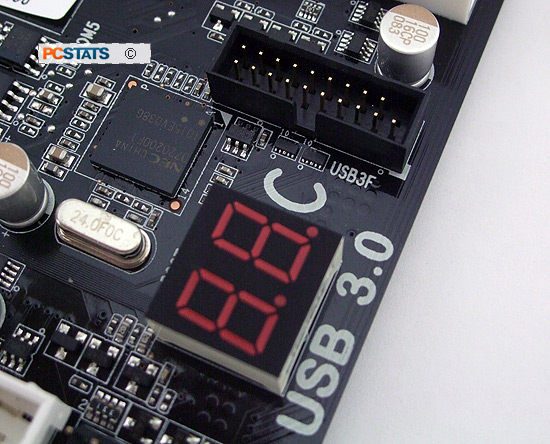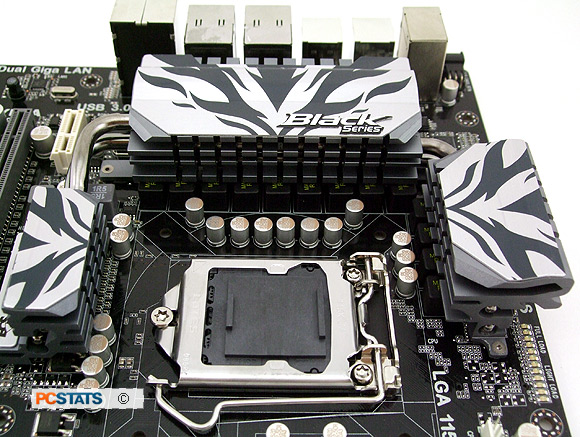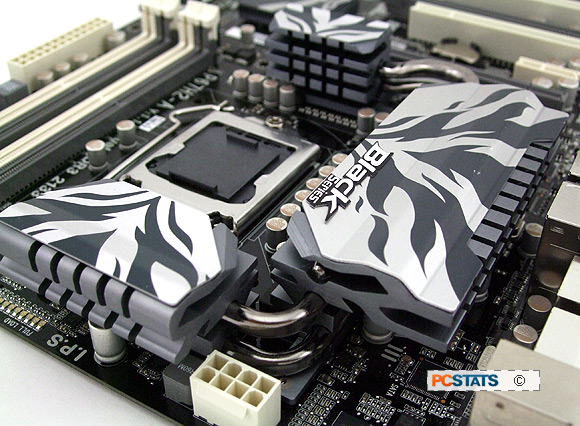360-Degree Motherboard Gallery:
Time for an
up close look at the layout of the ECS P67H2-A Black Extreme motherboard.
First up, three PCI Express
2.0 x16 slots. A single videocard will run in x16
mode while two-way videocards can be configured with Lucid's HydraLogix chipset to run in parallel,
in x16/x16 mode. Three videocards (including combinations of nVidia and AMD
videocards) will split the bandwidth and run in x16/x8/x8 mode. Remaining expansion
slots include two PCI Express 2.0 x1 slots and two legacy PCI
slots.
Spacing
between the first
two videocard PCI Express 2.0 x16 slots
is good. Dual-slot videocards only block one PCIEx1 slot. If you opt for 2-way
graphics via the Lucid HydraLogix chip, that will cost you a PCI slot as well. With either videocard scenario
there is lots of space for cooling and at least one PCIex1 card.
The expansion slots are all clearly marked which
is nice to see. Along the bottom of the ECS P67H2-A Black Extreme motherboard
you'll find a Audio header, COM port header, (1) USB 2.0 header for
EZ-charge devices, (3) USB 2.0 headers, (1) USB 3.0 header (bracket included!) and the front panel
connectors. There's a good amount of connectivity on the P67H2-A motherboard, particularly
given that the board has two eSATA III ports on
the rear I/O as well.
Near the front panel IO header and clear CMOS jumper (there's a clear CMOS
button on the rear I/O too) is a PORT80 diagnostics card, four 3Gb/s SATA II ports (white)
and two 6Gb/s SATA III jacks (gray). These SATA ports come via the Intel
P67 chipset so RAID 0/1/5/10 can be configured across any of them.
The Intel P67 Express
chipset doesn't produce that much heat so all it needs is a small, low profile
passive aluminum heatsink for cooling.
|

on
board Port 80 diagnostics card |
The PORT80
card is a two digit LED display that spits out codes based on what the system is
doing, or where in the boot process it is. Port 80 error codes are standardized
so it helps you diagnose boot issues or memory errors and things of that nature when your computer refuses to boot up. The BIOS allows
you to set the PORT80 display to report CPU temperature instead of status codes.
The
ECS P67H2-A Black Extreme motherboard supports DDR3-1066/1333/1600/1866/2133 memory
in a dual channel configuration. The largest memory density the four
1.5v DIMMs support for 64-bit operating systems is 16GB, for Windows 32-bit you're capped
at 4GB max.
|

LGA1155
CPU socket
|
Like all
Intel P67 platforms, the ECS P67H2-A Black Extreme motherboard accommodates 32nm
Intel socket LGA1155 2nd Generation 'Sandy Bridge' Core i3/i5/i7 2xxx-series
processors and is not backwards compatible with socket LGA1156 Lynnfield
chips.
|

LGA1155
CPU socket
|
The heatsink mounting holes are the same between LGA1156
and LGA1155 heatsinks. As long as aftermarket CPU coolers support one of those CPUs,
it will install on both. If in doubt, have a peek at
Frostytech's fantastic Top 5 Heatsink charts.
ECS' P67H2-A Black Extreme board has a pretty hefty thermal solution tacked on top
of the motherboard VRM MOSFETS. The extruded aluminum heatsinks are connected by
two heatpipes to the Lucid HydraLogix chip which is located between the CPU socket and
first videocard slot.
Here we have two SATA III ports and physical power and reset buttons to make
tweaking the system out of the box easier.
The NEC USB 3.0 controller supplies
two USB 3.0 ports which are capable of transferring data at a whopping 4.8Gb/s (4800Mb/s). This is more
than fast enough for today's inexpensive large mass storage devices.
ECS includes a nice black aluminum fronted USB 3.0, 2.5" front
bay bracket with the ECS P67H2-A Black Extreme motherboard.
Next up PCSTATS dives into Overclocking, then
it's time to hit the Benchmarks!
